Impact of Learning and Communication on RAECO Employees
VerifiedAdded on 2021/01/01
|16
|3188
|89
Report
AI Summary
This report investigates the impact of learning and communication on employees within RAECO, a rural electricity company. The research includes a literature review, outlining the importance of learning and communication for employee skill development and organizational success. The study employs an interpretivism philosophy and a qualitative, inductive approach, utilizing a survey with 50 employees to gather data. The findings indicate that effective learning significantly contributes to employees' knowledge and abilities, with 70% strongly agreeing. The analysis also reveals that a majority of employees perceive that open communication systems are in place. The report concludes with suggestions for improving learning and communication within RAECO, based on the survey responses and data analysis, with the goal of enhancing employee engagement and performance.
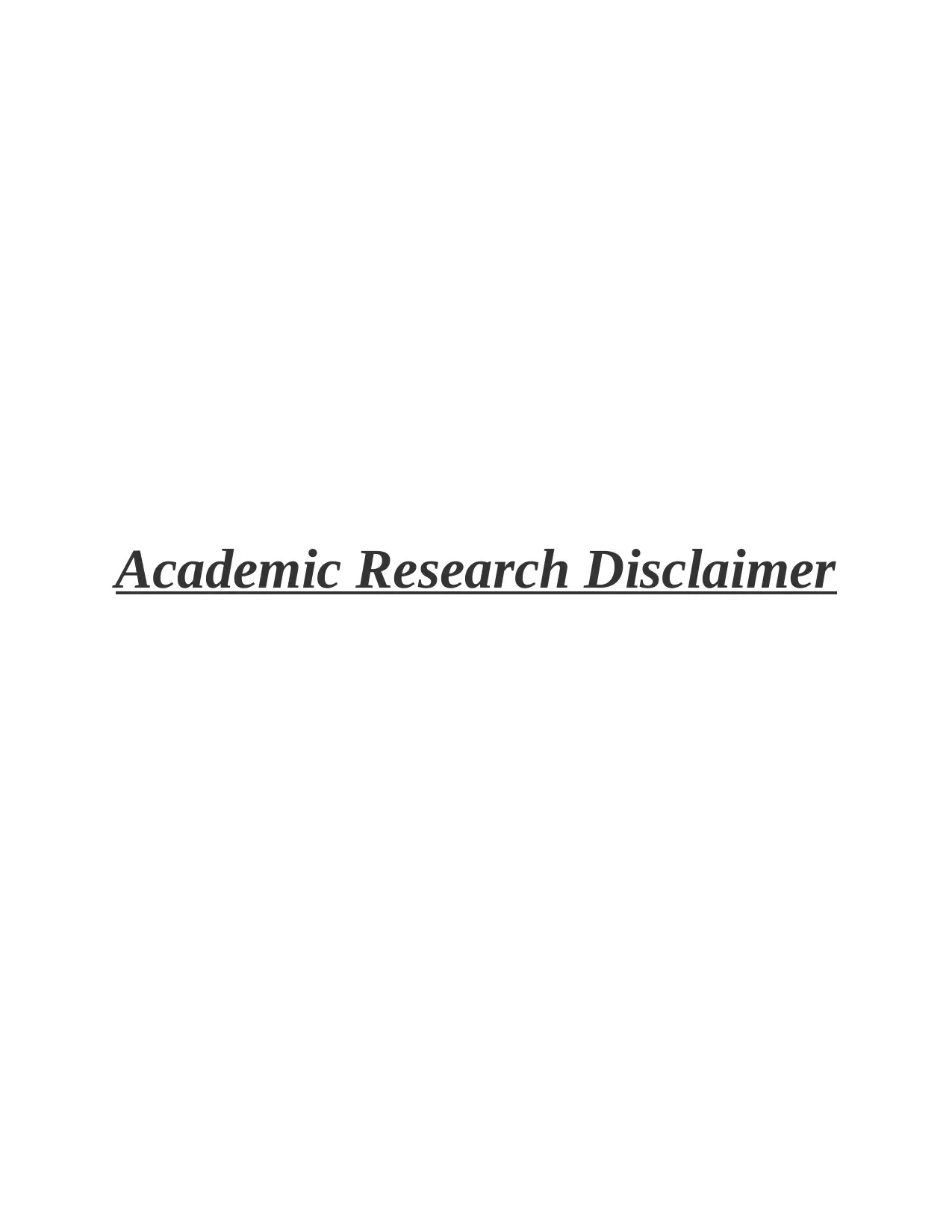
Academic Research Disclaimer
Paraphrase This Document
Need a fresh take? Get an instant paraphrase of this document with our AI Paraphraser
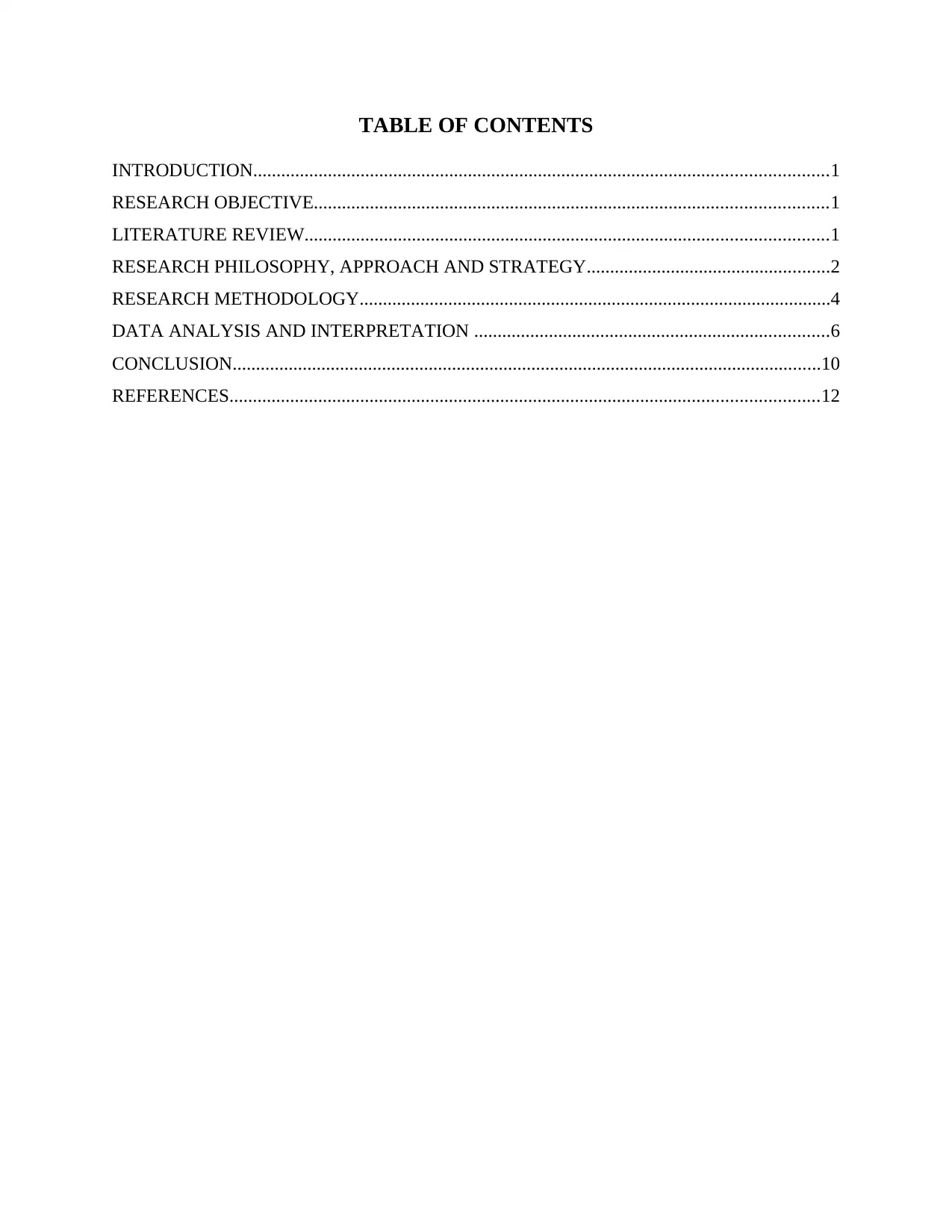
TABLE OF CONTENTS
INTRODUCTION...........................................................................................................................1
RESEARCH OBJECTIVE..............................................................................................................1
LITERATURE REVIEW................................................................................................................1
RESEARCH PHILOSOPHY, APPROACH AND STRATEGY....................................................2
RESEARCH METHODOLOGY.....................................................................................................4
DATA ANALYSIS AND INTERPRETATION ............................................................................6
CONCLUSION..............................................................................................................................10
REFERENCES..............................................................................................................................12
INTRODUCTION...........................................................................................................................1
RESEARCH OBJECTIVE..............................................................................................................1
LITERATURE REVIEW................................................................................................................1
RESEARCH PHILOSOPHY, APPROACH AND STRATEGY....................................................2
RESEARCH METHODOLOGY.....................................................................................................4
DATA ANALYSIS AND INTERPRETATION ............................................................................6
CONCLUSION..............................................................................................................................10
REFERENCES..............................................................................................................................12
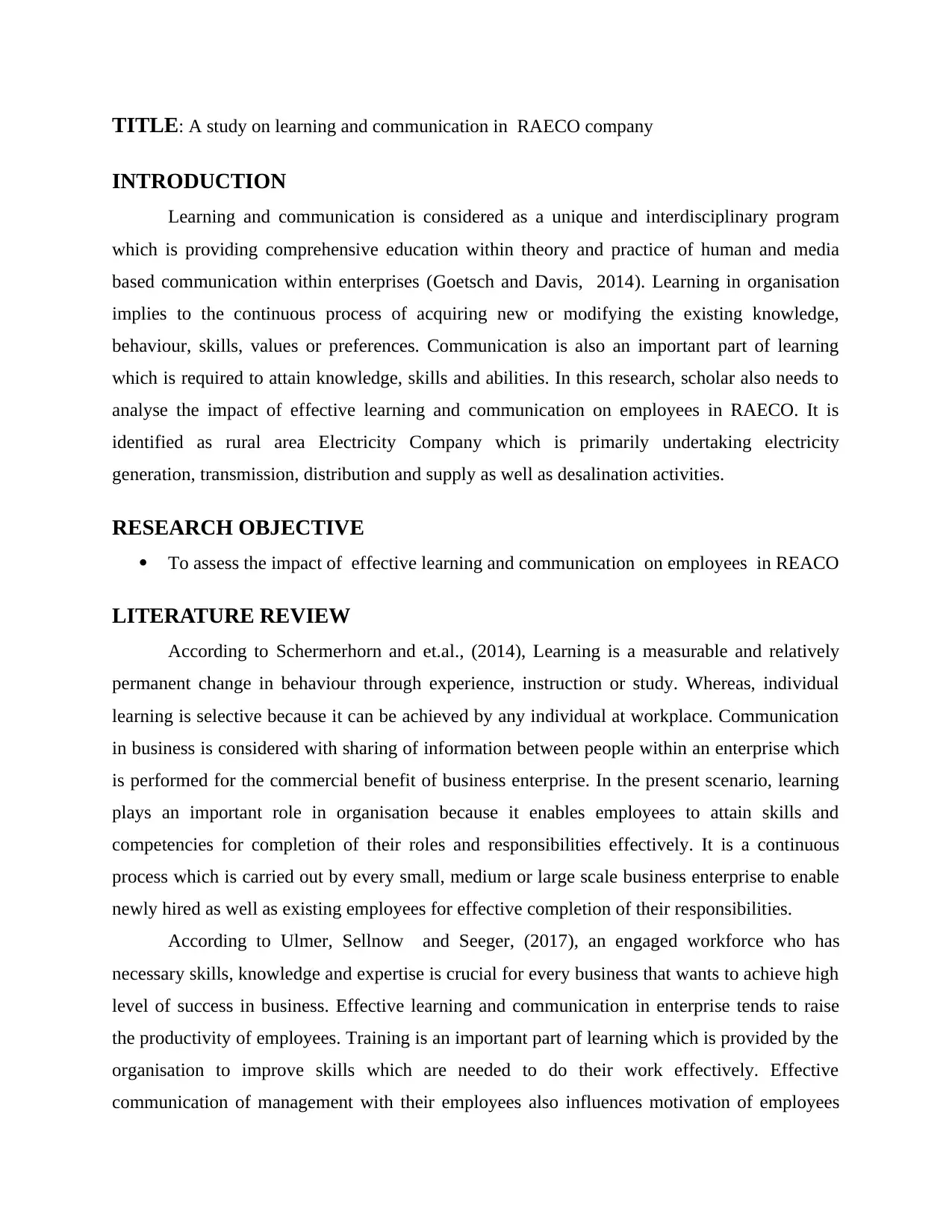
TITLE: A study on learning and communication in RAECO company
INTRODUCTION
Learning and communication is considered as a unique and interdisciplinary program
which is providing comprehensive education within theory and practice of human and media
based communication within enterprises (Goetsch and Davis, 2014). Learning in organisation
implies to the continuous process of acquiring new or modifying the existing knowledge,
behaviour, skills, values or preferences. Communication is also an important part of learning
which is required to attain knowledge, skills and abilities. In this research, scholar also needs to
analyse the impact of effective learning and communication on employees in RAECO. It is
identified as rural area Electricity Company which is primarily undertaking electricity
generation, transmission, distribution and supply as well as desalination activities.
RESEARCH OBJECTIVE
To assess the impact of effective learning and communication on employees in REACO
LITERATURE REVIEW
According to Schermerhorn and et.al., (2014), Learning is a measurable and relatively
permanent change in behaviour through experience, instruction or study. Whereas, individual
learning is selective because it can be achieved by any individual at workplace. Communication
in business is considered with sharing of information between people within an enterprise which
is performed for the commercial benefit of business enterprise. In the present scenario, learning
plays an important role in organisation because it enables employees to attain skills and
competencies for completion of their roles and responsibilities effectively. It is a continuous
process which is carried out by every small, medium or large scale business enterprise to enable
newly hired as well as existing employees for effective completion of their responsibilities.
According to Ulmer, Sellnow and Seeger, (2017), an engaged workforce who has
necessary skills, knowledge and expertise is crucial for every business that wants to achieve high
level of success in business. Effective learning and communication in enterprise tends to raise
the productivity of employees. Training is an important part of learning which is provided by the
organisation to improve skills which are needed to do their work effectively. Effective
communication of management with their employees also influences motivation of employees
INTRODUCTION
Learning and communication is considered as a unique and interdisciplinary program
which is providing comprehensive education within theory and practice of human and media
based communication within enterprises (Goetsch and Davis, 2014). Learning in organisation
implies to the continuous process of acquiring new or modifying the existing knowledge,
behaviour, skills, values or preferences. Communication is also an important part of learning
which is required to attain knowledge, skills and abilities. In this research, scholar also needs to
analyse the impact of effective learning and communication on employees in RAECO. It is
identified as rural area Electricity Company which is primarily undertaking electricity
generation, transmission, distribution and supply as well as desalination activities.
RESEARCH OBJECTIVE
To assess the impact of effective learning and communication on employees in REACO
LITERATURE REVIEW
According to Schermerhorn and et.al., (2014), Learning is a measurable and relatively
permanent change in behaviour through experience, instruction or study. Whereas, individual
learning is selective because it can be achieved by any individual at workplace. Communication
in business is considered with sharing of information between people within an enterprise which
is performed for the commercial benefit of business enterprise. In the present scenario, learning
plays an important role in organisation because it enables employees to attain skills and
competencies for completion of their roles and responsibilities effectively. It is a continuous
process which is carried out by every small, medium or large scale business enterprise to enable
newly hired as well as existing employees for effective completion of their responsibilities.
According to Ulmer, Sellnow and Seeger, (2017), an engaged workforce who has
necessary skills, knowledge and expertise is crucial for every business that wants to achieve high
level of success in business. Effective learning and communication in enterprise tends to raise
the productivity of employees. Training is an important part of learning which is provided by the
organisation to improve skills which are needed to do their work effectively. Effective
communication of management with their employees also influences motivation of employees
⊘ This is a preview!⊘
Do you want full access?
Subscribe today to unlock all pages.

Trusted by 1+ million students worldwide

and helps in the resolution of issues. Increase in motivation enables the staff to increase their
level of performance within enterprise.
2
level of performance within enterprise.
2
Paraphrase This Document
Need a fresh take? Get an instant paraphrase of this document with our AI Paraphraser
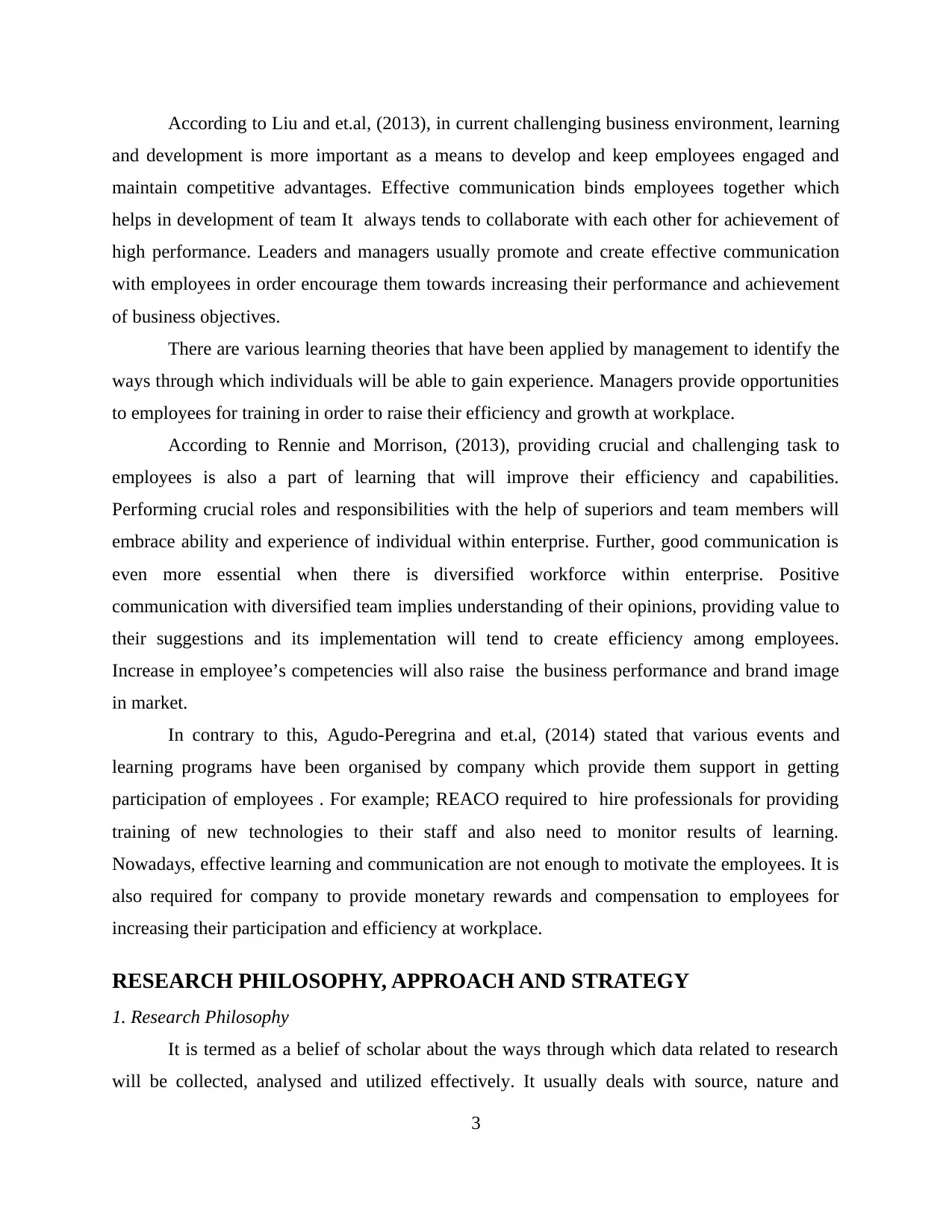
According to Liu and et.al, (2013), in current challenging business environment, learning
and development is more important as a means to develop and keep employees engaged and
maintain competitive advantages. Effective communication binds employees together which
helps in development of team It always tends to collaborate with each other for achievement of
high performance. Leaders and managers usually promote and create effective communication
with employees in order encourage them towards increasing their performance and achievement
of business objectives.
There are various learning theories that have been applied by management to identify the
ways through which individuals will be able to gain experience. Managers provide opportunities
to employees for training in order to raise their efficiency and growth at workplace.
According to Rennie and Morrison, (2013), providing crucial and challenging task to
employees is also a part of learning that will improve their efficiency and capabilities.
Performing crucial roles and responsibilities with the help of superiors and team members will
embrace ability and experience of individual within enterprise. Further, good communication is
even more essential when there is diversified workforce within enterprise. Positive
communication with diversified team implies understanding of their opinions, providing value to
their suggestions and its implementation will tend to create efficiency among employees.
Increase in employee’s competencies will also raise the business performance and brand image
in market.
In contrary to this, Agudo-Peregrina and et.al, (2014) stated that various events and
learning programs have been organised by company which provide them support in getting
participation of employees . For example; REACO required to hire professionals for providing
training of new technologies to their staff and also need to monitor results of learning.
Nowadays, effective learning and communication are not enough to motivate the employees. It is
also required for company to provide monetary rewards and compensation to employees for
increasing their participation and efficiency at workplace.
RESEARCH PHILOSOPHY, APPROACH AND STRATEGY
1. Research Philosophy
It is termed as a belief of scholar about the ways through which data related to research
will be collected, analysed and utilized effectively. It usually deals with source, nature and
3
and development is more important as a means to develop and keep employees engaged and
maintain competitive advantages. Effective communication binds employees together which
helps in development of team It always tends to collaborate with each other for achievement of
high performance. Leaders and managers usually promote and create effective communication
with employees in order encourage them towards increasing their performance and achievement
of business objectives.
There are various learning theories that have been applied by management to identify the
ways through which individuals will be able to gain experience. Managers provide opportunities
to employees for training in order to raise their efficiency and growth at workplace.
According to Rennie and Morrison, (2013), providing crucial and challenging task to
employees is also a part of learning that will improve their efficiency and capabilities.
Performing crucial roles and responsibilities with the help of superiors and team members will
embrace ability and experience of individual within enterprise. Further, good communication is
even more essential when there is diversified workforce within enterprise. Positive
communication with diversified team implies understanding of their opinions, providing value to
their suggestions and its implementation will tend to create efficiency among employees.
Increase in employee’s competencies will also raise the business performance and brand image
in market.
In contrary to this, Agudo-Peregrina and et.al, (2014) stated that various events and
learning programs have been organised by company which provide them support in getting
participation of employees . For example; REACO required to hire professionals for providing
training of new technologies to their staff and also need to monitor results of learning.
Nowadays, effective learning and communication are not enough to motivate the employees. It is
also required for company to provide monetary rewards and compensation to employees for
increasing their participation and efficiency at workplace.
RESEARCH PHILOSOPHY, APPROACH AND STRATEGY
1. Research Philosophy
It is termed as a belief of scholar about the ways through which data related to research
will be collected, analysed and utilized effectively. It usually deals with source, nature and
3
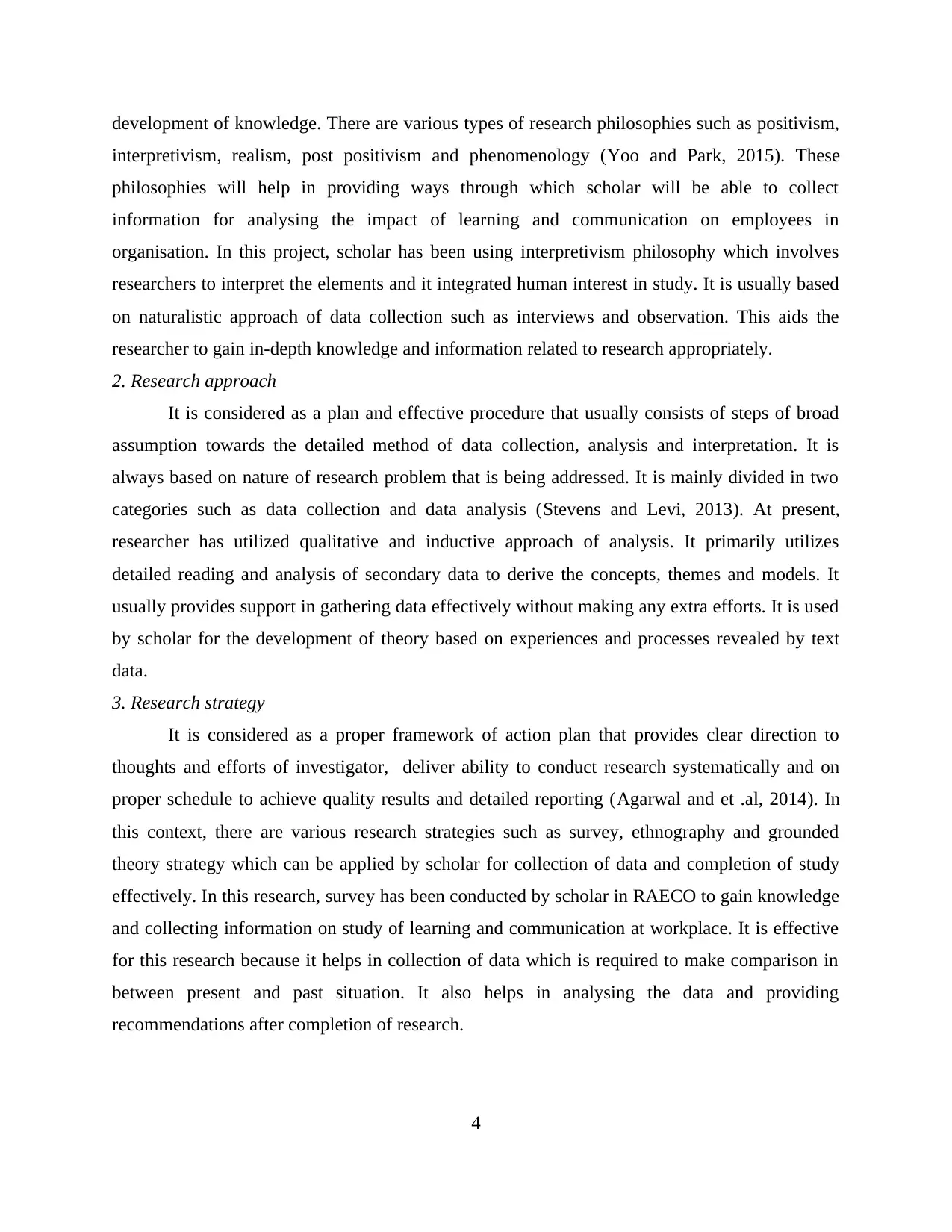
development of knowledge. There are various types of research philosophies such as positivism,
interpretivism, realism, post positivism and phenomenology (Yoo and Park, 2015). These
philosophies will help in providing ways through which scholar will be able to collect
information for analysing the impact of learning and communication on employees in
organisation. In this project, scholar has been using interpretivism philosophy which involves
researchers to interpret the elements and it integrated human interest in study. It is usually based
on naturalistic approach of data collection such as interviews and observation. This aids the
researcher to gain in-depth knowledge and information related to research appropriately.
2. Research approach
It is considered as a plan and effective procedure that usually consists of steps of broad
assumption towards the detailed method of data collection, analysis and interpretation. It is
always based on nature of research problem that is being addressed. It is mainly divided in two
categories such as data collection and data analysis (Stevens and Levi, 2013). At present,
researcher has utilized qualitative and inductive approach of analysis. It primarily utilizes
detailed reading and analysis of secondary data to derive the concepts, themes and models. It
usually provides support in gathering data effectively without making any extra efforts. It is used
by scholar for the development of theory based on experiences and processes revealed by text
data.
3. Research strategy
It is considered as a proper framework of action plan that provides clear direction to
thoughts and efforts of investigator, deliver ability to conduct research systematically and on
proper schedule to achieve quality results and detailed reporting (Agarwal and et .al, 2014). In
this context, there are various research strategies such as survey, ethnography and grounded
theory strategy which can be applied by scholar for collection of data and completion of study
effectively. In this research, survey has been conducted by scholar in RAECO to gain knowledge
and collecting information on study of learning and communication at workplace. It is effective
for this research because it helps in collection of data which is required to make comparison in
between present and past situation. It also helps in analysing the data and providing
recommendations after completion of research.
4
interpretivism, realism, post positivism and phenomenology (Yoo and Park, 2015). These
philosophies will help in providing ways through which scholar will be able to collect
information for analysing the impact of learning and communication on employees in
organisation. In this project, scholar has been using interpretivism philosophy which involves
researchers to interpret the elements and it integrated human interest in study. It is usually based
on naturalistic approach of data collection such as interviews and observation. This aids the
researcher to gain in-depth knowledge and information related to research appropriately.
2. Research approach
It is considered as a plan and effective procedure that usually consists of steps of broad
assumption towards the detailed method of data collection, analysis and interpretation. It is
always based on nature of research problem that is being addressed. It is mainly divided in two
categories such as data collection and data analysis (Stevens and Levi, 2013). At present,
researcher has utilized qualitative and inductive approach of analysis. It primarily utilizes
detailed reading and analysis of secondary data to derive the concepts, themes and models. It
usually provides support in gathering data effectively without making any extra efforts. It is used
by scholar for the development of theory based on experiences and processes revealed by text
data.
3. Research strategy
It is considered as a proper framework of action plan that provides clear direction to
thoughts and efforts of investigator, deliver ability to conduct research systematically and on
proper schedule to achieve quality results and detailed reporting (Agarwal and et .al, 2014). In
this context, there are various research strategies such as survey, ethnography and grounded
theory strategy which can be applied by scholar for collection of data and completion of study
effectively. In this research, survey has been conducted by scholar in RAECO to gain knowledge
and collecting information on study of learning and communication at workplace. It is effective
for this research because it helps in collection of data which is required to make comparison in
between present and past situation. It also helps in analysing the data and providing
recommendations after completion of research.
4
⊘ This is a preview!⊘
Do you want full access?
Subscribe today to unlock all pages.

Trusted by 1+ million students worldwide
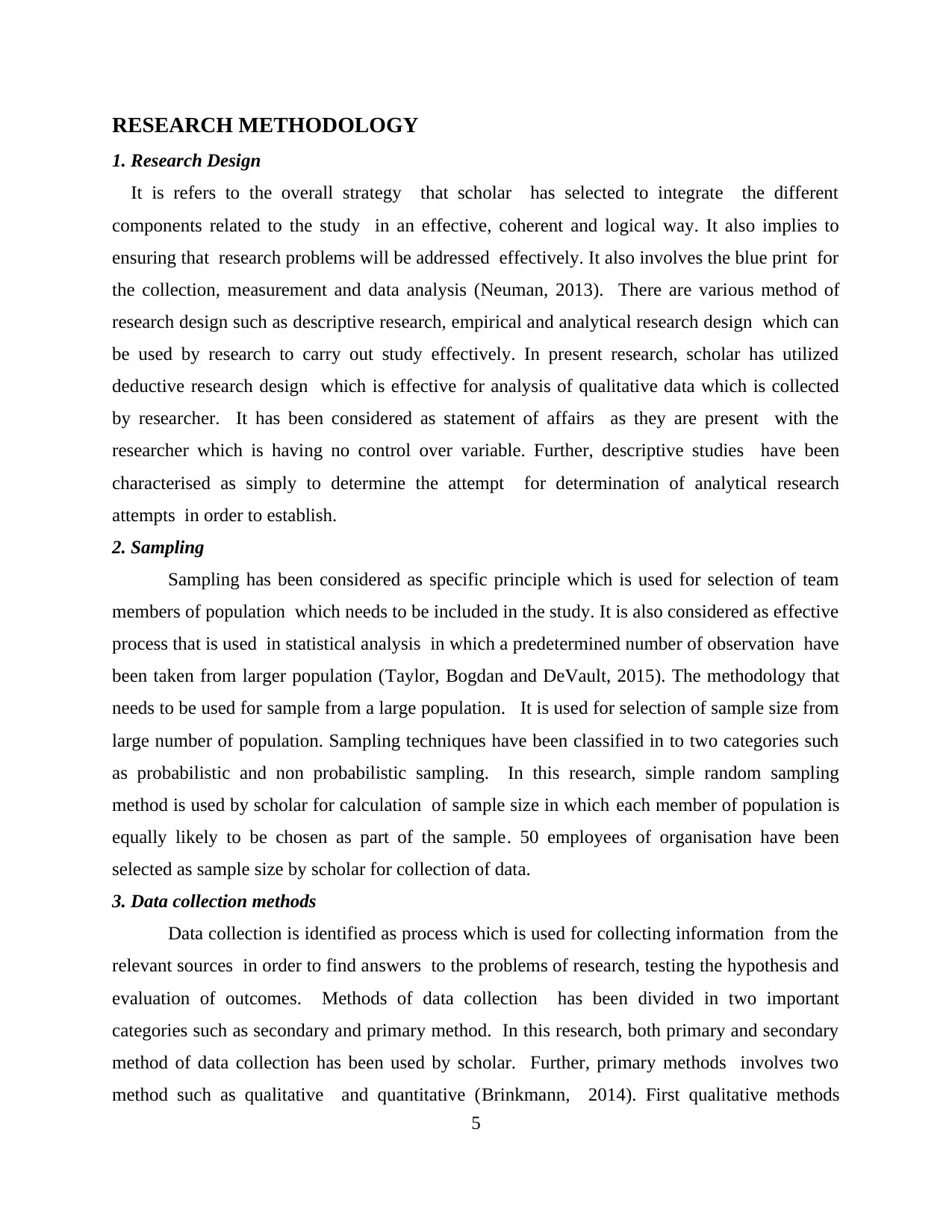
RESEARCH METHODOLOGY
1. Research Design
It is refers to the overall strategy that scholar has selected to integrate the different
components related to the study in an effective, coherent and logical way. It also implies to
ensuring that research problems will be addressed effectively. It also involves the blue print for
the collection, measurement and data analysis (Neuman, 2013). There are various method of
research design such as descriptive research, empirical and analytical research design which can
be used by research to carry out study effectively. In present research, scholar has utilized
deductive research design which is effective for analysis of qualitative data which is collected
by researcher. It has been considered as statement of affairs as they are present with the
researcher which is having no control over variable. Further, descriptive studies have been
characterised as simply to determine the attempt for determination of analytical research
attempts in order to establish.
2. Sampling
Sampling has been considered as specific principle which is used for selection of team
members of population which needs to be included in the study. It is also considered as effective
process that is used in statistical analysis in which a predetermined number of observation have
been taken from larger population (Taylor, Bogdan and DeVault, 2015). The methodology that
needs to be used for sample from a large population. It is used for selection of sample size from
large number of population. Sampling techniques have been classified in to two categories such
as probabilistic and non probabilistic sampling. In this research, simple random sampling
method is used by scholar for calculation of sample size in which each member of population is
equally likely to be chosen as part of the sample. 50 employees of organisation have been
selected as sample size by scholar for collection of data.
3. Data collection methods
Data collection is identified as process which is used for collecting information from the
relevant sources in order to find answers to the problems of research, testing the hypothesis and
evaluation of outcomes. Methods of data collection has been divided in two important
categories such as secondary and primary method. In this research, both primary and secondary
method of data collection has been used by scholar. Further, primary methods involves two
method such as qualitative and quantitative (Brinkmann, 2014). First qualitative methods
5
1. Research Design
It is refers to the overall strategy that scholar has selected to integrate the different
components related to the study in an effective, coherent and logical way. It also implies to
ensuring that research problems will be addressed effectively. It also involves the blue print for
the collection, measurement and data analysis (Neuman, 2013). There are various method of
research design such as descriptive research, empirical and analytical research design which can
be used by research to carry out study effectively. In present research, scholar has utilized
deductive research design which is effective for analysis of qualitative data which is collected
by researcher. It has been considered as statement of affairs as they are present with the
researcher which is having no control over variable. Further, descriptive studies have been
characterised as simply to determine the attempt for determination of analytical research
attempts in order to establish.
2. Sampling
Sampling has been considered as specific principle which is used for selection of team
members of population which needs to be included in the study. It is also considered as effective
process that is used in statistical analysis in which a predetermined number of observation have
been taken from larger population (Taylor, Bogdan and DeVault, 2015). The methodology that
needs to be used for sample from a large population. It is used for selection of sample size from
large number of population. Sampling techniques have been classified in to two categories such
as probabilistic and non probabilistic sampling. In this research, simple random sampling
method is used by scholar for calculation of sample size in which each member of population is
equally likely to be chosen as part of the sample. 50 employees of organisation have been
selected as sample size by scholar for collection of data.
3. Data collection methods
Data collection is identified as process which is used for collecting information from the
relevant sources in order to find answers to the problems of research, testing the hypothesis and
evaluation of outcomes. Methods of data collection has been divided in two important
categories such as secondary and primary method. In this research, both primary and secondary
method of data collection has been used by scholar. Further, primary methods involves two
method such as qualitative and quantitative (Brinkmann, 2014). First qualitative methods
5
Paraphrase This Document
Need a fresh take? Get an instant paraphrase of this document with our AI Paraphraser
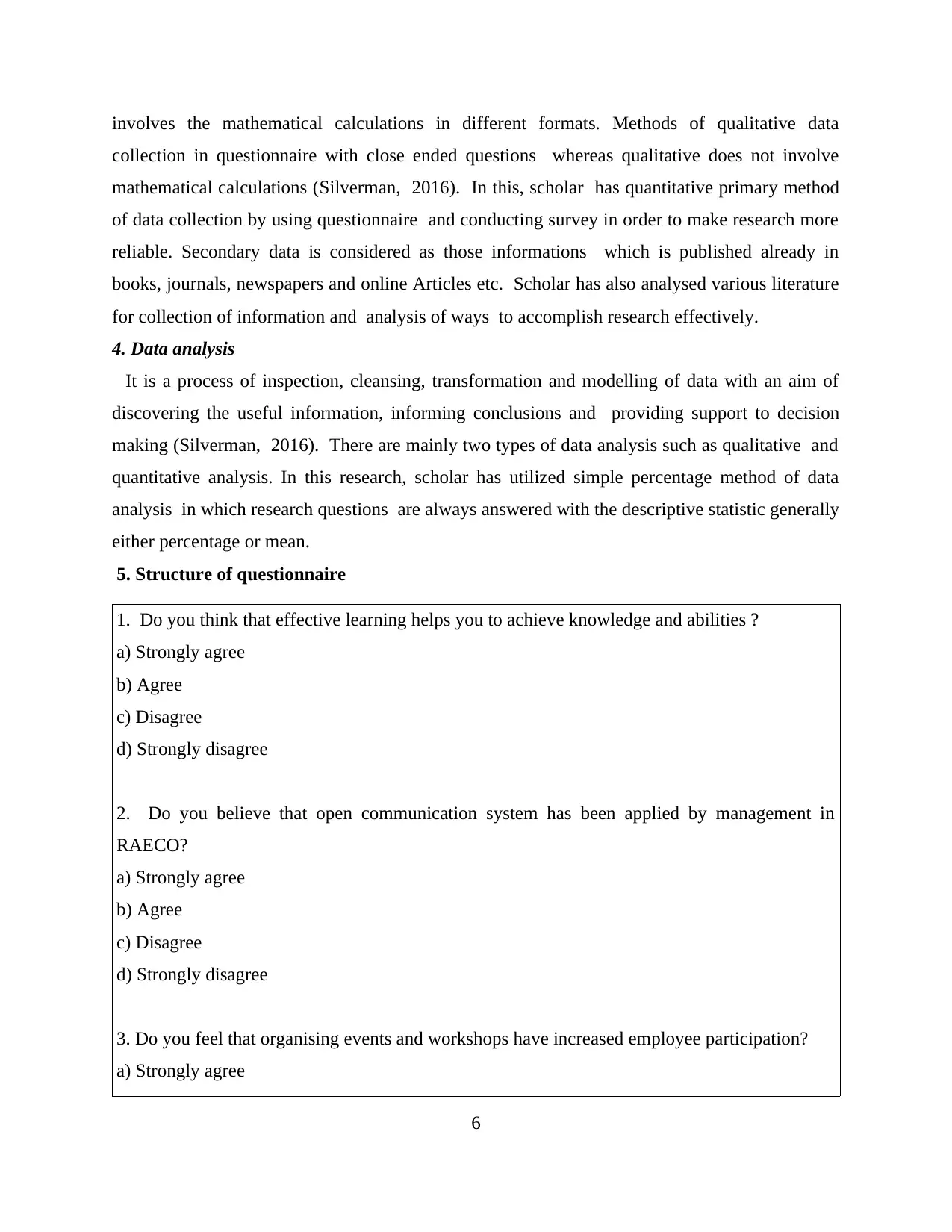
involves the mathematical calculations in different formats. Methods of qualitative data
collection in questionnaire with close ended questions whereas qualitative does not involve
mathematical calculations (Silverman, 2016). In this, scholar has quantitative primary method
of data collection by using questionnaire and conducting survey in order to make research more
reliable. Secondary data is considered as those informations which is published already in
books, journals, newspapers and online Articles etc. Scholar has also analysed various literature
for collection of information and analysis of ways to accomplish research effectively.
4. Data analysis
It is a process of inspection, cleansing, transformation and modelling of data with an aim of
discovering the useful information, informing conclusions and providing support to decision
making (Silverman, 2016). There are mainly two types of data analysis such as qualitative and
quantitative analysis. In this research, scholar has utilized simple percentage method of data
analysis in which research questions are always answered with the descriptive statistic generally
either percentage or mean.
5. Structure of questionnaire
1. Do you think that effective learning helps you to achieve knowledge and abilities ?
a) Strongly agree
b) Agree
c) Disagree
d) Strongly disagree
2. Do you believe that open communication system has been applied by management in
RAECO?
a) Strongly agree
b) Agree
c) Disagree
d) Strongly disagree
3. Do you feel that organising events and workshops have increased employee participation?
a) Strongly agree
6
collection in questionnaire with close ended questions whereas qualitative does not involve
mathematical calculations (Silverman, 2016). In this, scholar has quantitative primary method
of data collection by using questionnaire and conducting survey in order to make research more
reliable. Secondary data is considered as those informations which is published already in
books, journals, newspapers and online Articles etc. Scholar has also analysed various literature
for collection of information and analysis of ways to accomplish research effectively.
4. Data analysis
It is a process of inspection, cleansing, transformation and modelling of data with an aim of
discovering the useful information, informing conclusions and providing support to decision
making (Silverman, 2016). There are mainly two types of data analysis such as qualitative and
quantitative analysis. In this research, scholar has utilized simple percentage method of data
analysis in which research questions are always answered with the descriptive statistic generally
either percentage or mean.
5. Structure of questionnaire
1. Do you think that effective learning helps you to achieve knowledge and abilities ?
a) Strongly agree
b) Agree
c) Disagree
d) Strongly disagree
2. Do you believe that open communication system has been applied by management in
RAECO?
a) Strongly agree
b) Agree
c) Disagree
d) Strongly disagree
3. Do you feel that organising events and workshops have increased employee participation?
a) Strongly agree
6
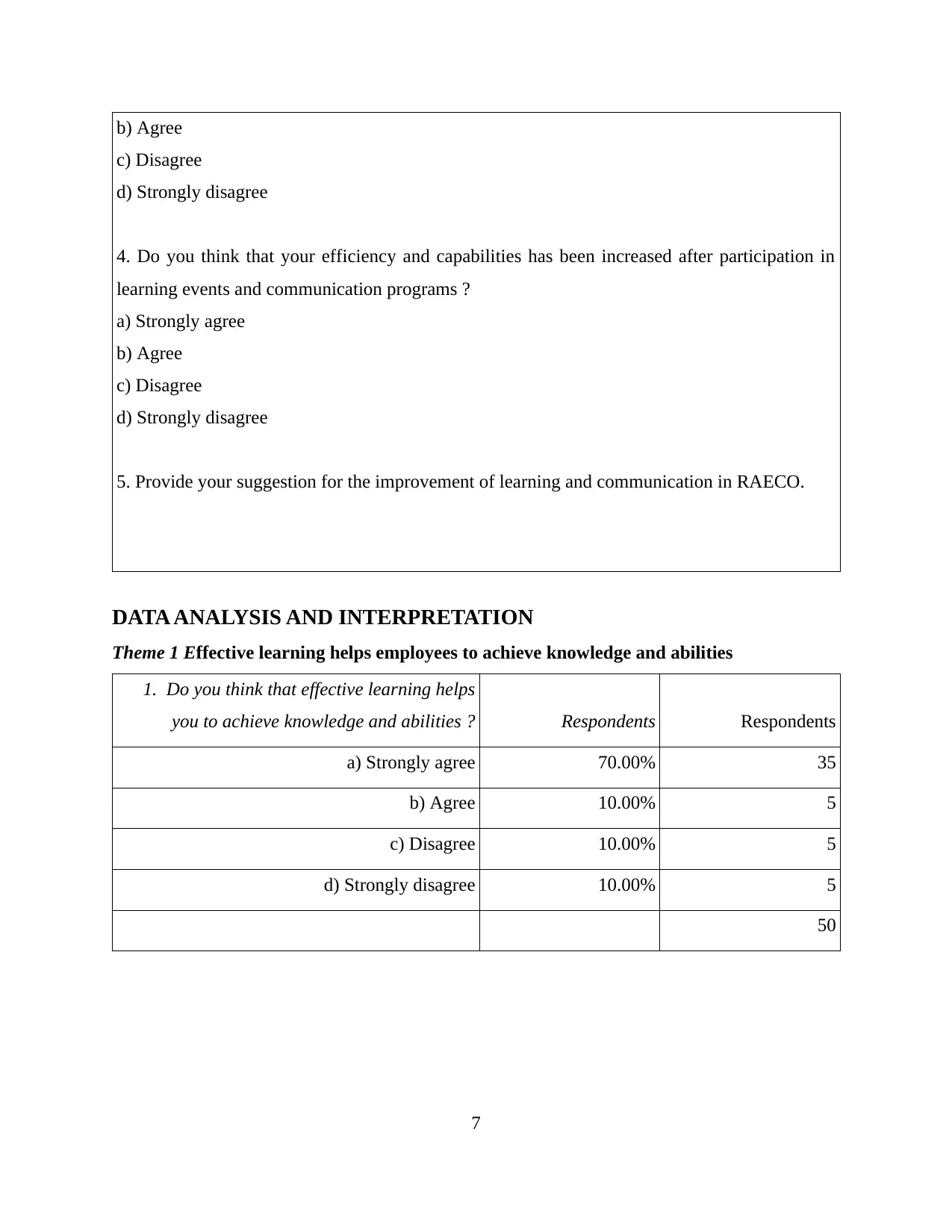
b) Agree
c) Disagree
d) Strongly disagree
4. Do you think that your efficiency and capabilities has been increased after participation in
learning events and communication programs ?
a) Strongly agree
b) Agree
c) Disagree
d) Strongly disagree
5. Provide your suggestion for the improvement of learning and communication in RAECO.
DATA ANALYSIS AND INTERPRETATION
Theme 1 Effective learning helps employees to achieve knowledge and abilities
1. Do you think that effective learning helps
you to achieve knowledge and abilities ? Respondents Respondents
a) Strongly agree 70.00% 35
b) Agree 10.00% 5
c) Disagree 10.00% 5
d) Strongly disagree 10.00% 5
50
7
c) Disagree
d) Strongly disagree
4. Do you think that your efficiency and capabilities has been increased after participation in
learning events and communication programs ?
a) Strongly agree
b) Agree
c) Disagree
d) Strongly disagree
5. Provide your suggestion for the improvement of learning and communication in RAECO.
DATA ANALYSIS AND INTERPRETATION
Theme 1 Effective learning helps employees to achieve knowledge and abilities
1. Do you think that effective learning helps
you to achieve knowledge and abilities ? Respondents Respondents
a) Strongly agree 70.00% 35
b) Agree 10.00% 5
c) Disagree 10.00% 5
d) Strongly disagree 10.00% 5
50
7
⊘ This is a preview!⊘
Do you want full access?
Subscribe today to unlock all pages.

Trusted by 1+ million students worldwide

Interpretation: From the above chart, it is clear that 70% Strongly agree that effective learning
helps them to achieve knowledge and abilities. 10% are only agree, 10 % respondents are not
agreed because they did not think that whereas 10% respondents are strongly disagree with this
statements. However, it can be said that effective learning helps employees to achieve
knowledge and abilities
Theme 2 open communication system has been applied by management in RAECO
2. Do you believe that open communication
system has been applied by management in
RAECO? Respondents Respondents
a) Strongly agree 60.00% 30
b) Agree 20.00% 10
c) Disagree 10.00% 5
d) Strongly disagree 10.00% 5
8
70.00%
10.00%
10.00%
10.00%
a) Strongly agree
b) Agree
c) Disagree
d) Strongly disagree
helps them to achieve knowledge and abilities. 10% are only agree, 10 % respondents are not
agreed because they did not think that whereas 10% respondents are strongly disagree with this
statements. However, it can be said that effective learning helps employees to achieve
knowledge and abilities
Theme 2 open communication system has been applied by management in RAECO
2. Do you believe that open communication
system has been applied by management in
RAECO? Respondents Respondents
a) Strongly agree 60.00% 30
b) Agree 20.00% 10
c) Disagree 10.00% 5
d) Strongly disagree 10.00% 5
8
70.00%
10.00%
10.00%
10.00%
a) Strongly agree
b) Agree
c) Disagree
d) Strongly disagree
Paraphrase This Document
Need a fresh take? Get an instant paraphrase of this document with our AI Paraphraser
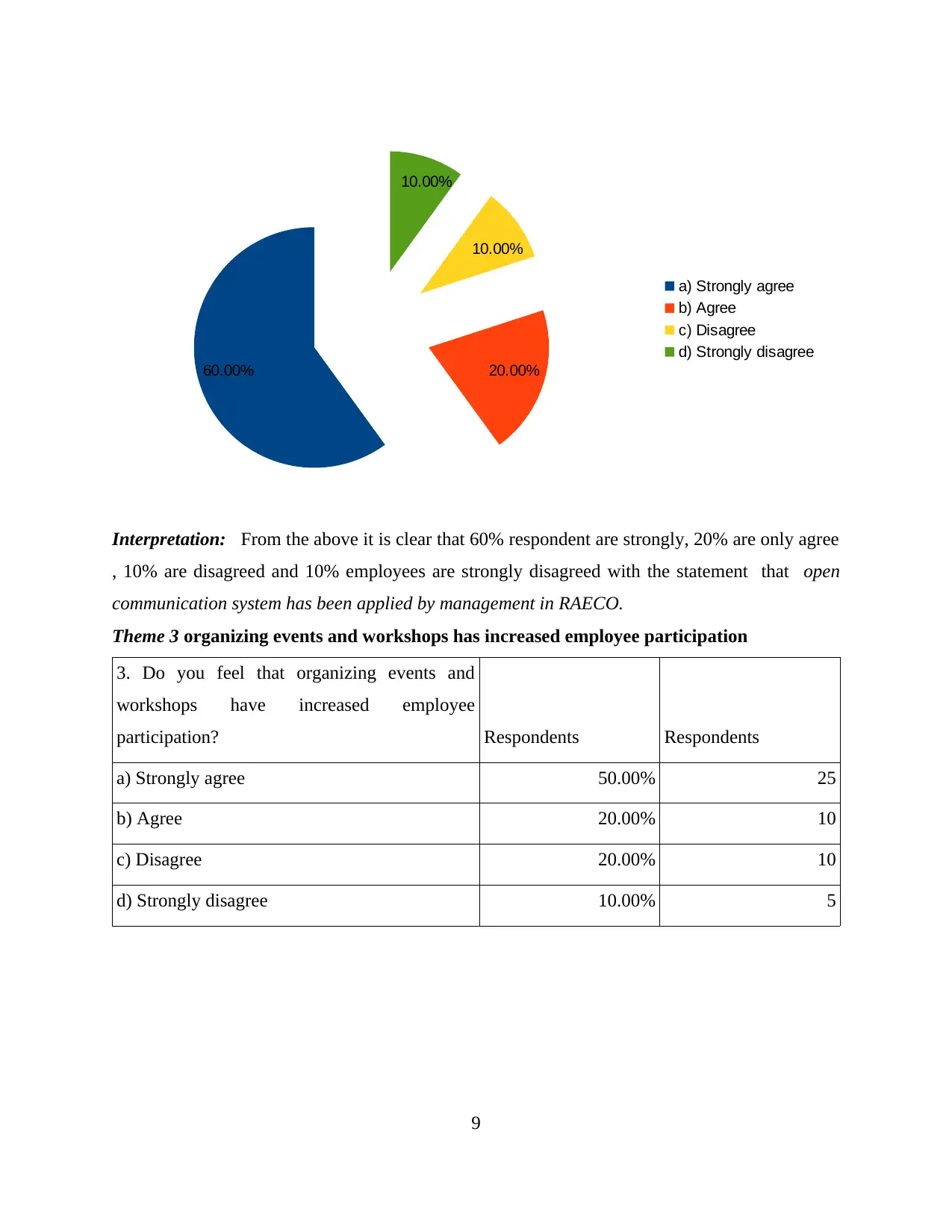
Interpretation: From the above it is clear that 60% respondent are strongly, 20% are only agree
, 10% are disagreed and 10% employees are strongly disagreed with the statement that open
communication system has been applied by management in RAECO.
Theme 3 organizing events and workshops has increased employee participation
3. Do you feel that organizing events and
workshops have increased employee
participation? Respondents Respondents
a) Strongly agree 50.00% 25
b) Agree 20.00% 10
c) Disagree 20.00% 10
d) Strongly disagree 10.00% 5
9
60.00% 20.00%
10.00%
10.00%
a) Strongly agree
b) Agree
c) Disagree
d) Strongly disagree
, 10% are disagreed and 10% employees are strongly disagreed with the statement that open
communication system has been applied by management in RAECO.
Theme 3 organizing events and workshops has increased employee participation
3. Do you feel that organizing events and
workshops have increased employee
participation? Respondents Respondents
a) Strongly agree 50.00% 25
b) Agree 20.00% 10
c) Disagree 20.00% 10
d) Strongly disagree 10.00% 5
9
60.00% 20.00%
10.00%
10.00%
a) Strongly agree
b) Agree
c) Disagree
d) Strongly disagree
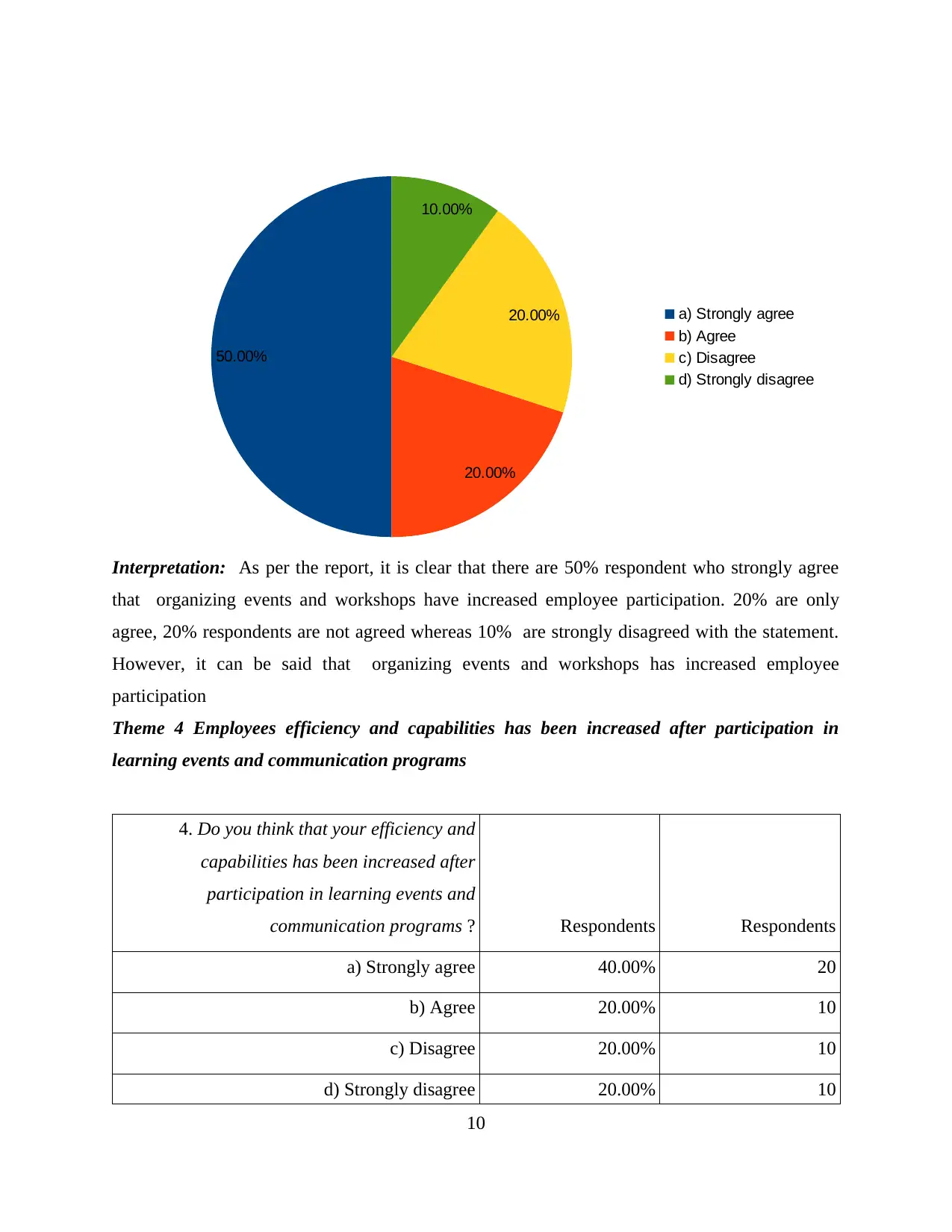
Interpretation: As per the report, it is clear that there are 50% respondent who strongly agree
that organizing events and workshops have increased employee participation. 20% are only
agree, 20% respondents are not agreed whereas 10% are strongly disagreed with the statement.
However, it can be said that organizing events and workshops has increased employee
participation
Theme 4 Employees efficiency and capabilities has been increased after participation in
learning events and communication programs
4. Do you think that your efficiency and
capabilities has been increased after
participation in learning events and
communication programs ? Respondents Respondents
a) Strongly agree 40.00% 20
b) Agree 20.00% 10
c) Disagree 20.00% 10
d) Strongly disagree 20.00% 10
10
50.00%
20.00%
20.00%
10.00%
a) Strongly agree
b) Agree
c) Disagree
d) Strongly disagree
that organizing events and workshops have increased employee participation. 20% are only
agree, 20% respondents are not agreed whereas 10% are strongly disagreed with the statement.
However, it can be said that organizing events and workshops has increased employee
participation
Theme 4 Employees efficiency and capabilities has been increased after participation in
learning events and communication programs
4. Do you think that your efficiency and
capabilities has been increased after
participation in learning events and
communication programs ? Respondents Respondents
a) Strongly agree 40.00% 20
b) Agree 20.00% 10
c) Disagree 20.00% 10
d) Strongly disagree 20.00% 10
10
50.00%
20.00%
20.00%
10.00%
a) Strongly agree
b) Agree
c) Disagree
d) Strongly disagree
⊘ This is a preview!⊘
Do you want full access?
Subscribe today to unlock all pages.

Trusted by 1+ million students worldwide
1 out of 16
Related Documents
Your All-in-One AI-Powered Toolkit for Academic Success.
+13062052269
info@desklib.com
Available 24*7 on WhatsApp / Email
![[object Object]](/_next/static/media/star-bottom.7253800d.svg)
Unlock your academic potential
Copyright © 2020–2025 A2Z Services. All Rights Reserved. Developed and managed by ZUCOL.




